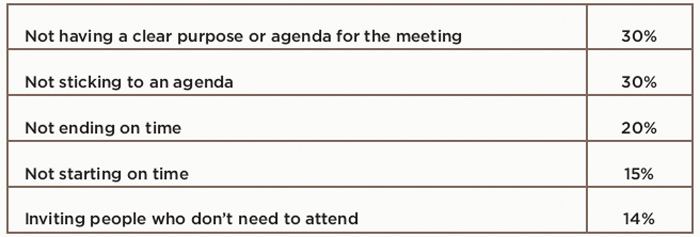
Image Credit: Monkey Business Images/shutterstock.com
As a physician, you need to focus on your patients’ needs. As someone who owns or manages a rheumatology practice, you need to focus on your business’s needs. “This can feel like you’re not only wearing two different hats, but that you also have to be two different people,” says Virginia Fraser, global content specialist, Insights Learning & Development, Austin, Texas.
However, trying to be everything to everyone is a prescription for failure, continues Ms. Fraser, whose firm focuses on developing individuals, teams and leaders. “It is important for doctors who run a business to capitalize on their skills and leverage their interpersonal strengths, training and abilities as analysts and problem solvers to serve their patients and staff in similar ways,” she says.
One place where the role of physician and business owner converge is running staff meetings. “Effective meetings have the power to leave a staff feeling invigorated, informed, collaborative and goal oriented,” Ms. Fraser says.
“Conversely, ineffective staff meetings have the power to leave a staff feeling deflated, confused, stifled and without direction. Both outcomes impact a staff’s productivity level, engagement and effectiveness in their roles.”
Rheumatologists who own or operate a practice can vastly improve the outcome of routine staff meetings by employing some simple strategies, beginning with planning ahead for the meeting.
No. 1: Provide a Clear Objective; Prepare in Advance

Dr. Crow
Mary K. Crow, MD, chief, Division of Rheumatology, Hospital for Special Surgery, New York, says it’s helpful to provide a brief agenda ahead of time to give attendees an expectation of what will occur. This encourages staff to develop preliminary thoughts and suggestions they can bring up at the meeting.
“Just as you would thoroughly review a patient’s chart before meeting with them, do the same level of preparation before meeting with your staff,” Ms. Fraser continues. To prepare, you may want to review meeting minutes from the previous session or create and circulate an agenda based on open items and requests for further direction from staff.
“Staff will lose confidence in their leader’s competency if they spend meetings reviewing the same agenda items as the previous meeting without outlining next steps or seeing any type of resolution.”
Staff meetings should have limited surprises and clear expectations. “Brief your team at the onset regarding why you’re there, what you’re intending to do and how you will spend the next period of time achieving the intended result,” Ms. Fraser says.
No. 2: Schedule It at a Good Time
No one wants to attend a meeting first thing in the morning, at lunchtime or late in the day. “They want to use those parts of the day, respectively, to get ramped up, enjoy their personal time and tie up loose ends—not sit in a stuffy room for a drawn-out conversation,” says Tim Hird, executive director, Robert Half Management Resources, San Ramon, Calif.
Show employees you respect their time by scheduling meetings properly. If you plan a morning meeting, for example, ensure everyone will at least have a chance to get set for the day.
One effective option is a pre-lunch meeting. “Attendees will stay focused and avoid tangential discussions because they won’t want to lose lunch time,” says Mr. Hird, whose company provides senior-level financial professionals on a project and interim basis.

Ms. Amundson
On the other hand, Diane Amundson, CSP, owner, Diane Amundson & Associates—a firm focused on increasing workplace productivity in Winona, Minn.—advises having short stand-up meetings within the first half hour of everyone’s morning arrival. This might include video conferencing to those in remote or satellite offices. Weekly tactical meetings to address issues that need to be handled immediately should be held as consistently as possible each week (e.g., every Tuesday or Wednesday at the same time). “This will help individuals better plan to make the meeting with fewer excuses for not attending,” she says.
No. 3: Invite the Right People
By inviting only the people who need to attend, managers help keep meetings on track because only those with a vested interest in the discussion and outcome are present. “Staff will ask fewer questions because no one needs to wonder why they’re there or ask about rudimentary issues on the topic or initiative,” says Mr. Hird.
Ms. Amundson points out that you may also want to consider whom not to invite. “Sometimes, upper-level leaders can intimidate a group’s conversation,” she says. “If higher-level leaders tend to dominate or take over meetings, you may want to ask them to meet with the staff after they have had a chance to dialogue and discuss an issue amongst themselves.”
No. 4: Create a Well-Thought-Out Agenda
Be sure to start a meeting on time, even if few people are present. “If you continually wait for everyone to show up, you’ll encourage tardiness,” Ms. Amundson says.
Then, the best way to keep a meeting on track is to give it a track to go on. An agenda should include who is gathering the information, presenting it and facilitating the discussion.
“If you show a propensity for veering off the agenda, people will quickly become distracted and deflated,” Mr. Hird says. “They’ll think—fairly or not—that you aren’t concerned about their time or the issue at hand. Sitting through off-topic conversations and the resulting drawn-out meeting can be very frustrating.”
But Dr. Crow says it’s also important to allow time for some free flow of ideas. “This provides an opportunity to solicit novel and creative concepts,” she says.
When this occurs, Ms. Amundson suggests using a tool she calls “the parking lot.” Record on a sheet of flipchart paper important topics that must be addressed at some point but are not relevant at the present meeting. “This does several things: It validates the participant who brings up the issue to encourage idea exchanges and also allows the group to redirect the conversation back to the agenda quickly,” she says.
No. 5: Encourage Discussion & Participation

Ms. Fraser
Just as a patient’s health would be in danger if they withheld information about their health or history, a staff’s collective health could be in danger if members of the team are not comfortable voicing concerns or sharing relevant information with the group. “Reserve space in the meeting for unaddressed issues and encourage feedback and input during this time,” Ms. Fraser says.
Sometimes, individuals tend to be quiet because they have had their ideas invalidated or shot down by a dominant leader or co-worker in the past. Be sure to protect everyone’s ideas.
To encourage participation, compliment others who make comments, Ms. Amundson advises. Also, simply calling on a shy individual can work wonderfully. Say something like, “Sally, do you have anything to add?” and then praise her for her contribution.
No. 6: Reel in Contributors Who Go Off on a Tangent
Busy workers don’t want to sit through side conversations and discussions that don’t relate to them. In addition, by letting people talk off topic, you’ll be perceived as an ineffective leader, unable to manage discussions or staff. “If you want to be seen as a leader, make sure you can run a meeting,” Mr. Hird says.
If you are recording the meeting on a flipchart, ask the person speaking to sum up their idea so you can write it succinctly. Add it to the parking lot to discuss at another time.
No. 7: Visually Track Decision-Making Discussions
Dr. Crow is an advocate of flexible and mutable strategic plans. “Developing a strategic plan for a group stimulates participation and engagement and allows everyone to voice their ideas and views,” she says. “Once a strategic plan is in place, it represents a framework for prioritizing the group’s work.”
Ms. Amundson suggests writing these headings on flipchart paper: decision, discussion, action items, parking lot, next meeting agenda items. Designate one person to write items under the headings. “This becomes the group’s memory and allows for piggybacking of ideas as well as a common understanding when everyone leaves as to what was decided and next steps,” she says.
No. 8: Manage Conflict & Deal with Difficult People
It’s good to have different viewpoints during a staff meeting. But many meeting leaders fear conflict, so they immediately try to quiet any disagreement. “I encourage dissention, as long as it’s respectful,” Ms. Amundson says. One way to foster respectful conversation is to create meeting or group norms, along with staff, such as one person speaks at a time, don’t have sidebar conversations and turn off cell phones.
“The leader is responsible for making sure the norms are upheld, but staff members will help enforce these norms—especially if they had a part in creating them,” Ms. Amundson says.
If a member is not contributing, not showing up to meetings, not doing homework or not following through, the employee’s manager needs to step in. “Handle this through the progressive discipline process of the employee handbook (e.g., verbal warning, written warning and so forth),” Ms. Amundson says.
When Dr. Crow encounters a conflict among colleagues, which is rare, she will typically meet with individuals to fully understand the issue. “I emphasize patience when working cohesively to minimize or eliminate conflict,” she says. “During a group meeting, it is best to spend time fine-tuning the overall objective of the group’s work so that there is a clear understanding of group expectations, which will in turn prevent negative encounters among colleagues.”
No. 9: Stick to the Set End Time
Ending on time is critical, because you want to honor everyone’s time. If you need to continue the meeting, ask the group for permission to do so. Make sure this doesn’t happen at every meeting, because this can create anxiety in attendees who will anticipate that the agenda won’t be covered.

Mr. Hird
Another problem this creates is that attendees will think the organizer doesn’t care about their time and other responsibilities. “If you’re nearing the end time and there is more discussion to have, tell participants that you’ll send a follow-up communication or schedule a brief discussion to finish at a later time,” Mr. Hird says.
If you’re consistently running late with meetings, it’s likely a sign of larger issues, Mr. Hird continues. For example, you may be trying to pack too much into the time slot, discussions are poorly organized or your meetings run off topic.
No. 10: Close with an Action Plan
A meeting will be successful only if you take action on what was discussed and keep timelines in mind. But too many actions can be overwhelming, says Dr. Crow. Ideally, only two or three stated actions will be defined to make them more likely to be remembered and acted upon.
Some covered items will need an immediate decision, and others need to incubate for a while. “Make sure the next step is communicated consistently to those who didn’t attend,” Ms. Amundson says. “One person should share what was decided with absent members.”
You Can Do It
Keep in mind that what makes you a good doctor makes you a good leader. When you feel like you have to be two different people, you are probably acting like two different people and quite literally coming across as Dr. Jekyll and Mr. Hyde. “This professional duality can cause numerous challenges, because people don’t know what to expect from you or when you’re being your authentic self,” Ms. Fraser says. “Leading with who you are and what has made you an effective physician is how you’ll be able to successfully navigate the challenges of being an effective business owner or manager.”
Karen Appold is a medical writer in Pennsylvania.
Mixing Up Meetings: Deviate from the mundane
One advantage to mixing up staff meetings—from changing the format to adding ice breakers or other activities—is you keep employees on their toes. “They pay attention because they don’t know what will happen next,” says Tim Hird, executive director, Robert Half Management Resources, San Ramon, Calif.
To take a break from mundane meetings, Diane Amundson, CSP, owner, Diane Amundson & Associates, Winona, Minn., suggests “walking meetings.” While these work best one on one, small groups find them helpful as well. “Use them for brainstorming, troubleshooting and just getting to know each other better. Walking together can be a way to increase productivity when many staff members may want to kick back,” she says. In bad weather, try walking at a mall or workout facility.
Mr. Hird is also a proponent of outside meetings. “The sunshine and fresh air invigorate and put people in a refreshed state of mind,” he says.
If you have only a few updates for a group, consider asking everyone to stand. “Attendees won’t sidetrack the conversation because they won’t want to stand longer than necessary,” Mr. Hird says.
Why Meetings Fall Short
More than 400 workers were asked: “Which of the following mistakes do meeting leaders commonly make?” Here’s what they said:

Courtesy of Robert Half Management Resources
In a Robert Half Management Resources survey, more than 400 workers were asked: “In general, what percentage of the time you spend in meetings is wasted?” The mean answer was 25%.


